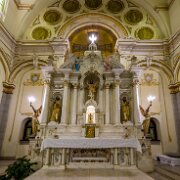
5 St. Charles Borromeo Roman Catholic Church is a church located at the corner of Baldwin Avenue and St. Paul Avenue in Detroit, Michigan
In the late 1850s, Belgian Catholics immigrated to Detroit and settled in the eastside neighborhoods near Gratiot and Baldwin. In 1886, a parish dedicated to St. Charles Borromeo was established to minister to this congregation. A wood-frame church was constructed for the parish, and quickly expanded. As Detroit grew, the parish grew along with it, with French, German, Irish, Scotch, and English immigrant congregants in addition to the original Belgians. By 1920, the congregation numbered over 3000. By the 1930s, the school's population also included many Catholic children of Syrian and Italian immigrants.
In 1912, the two-story rectory and school was designed and built by Van Leyen & Schilling. In 1918, Peter Dederichs was awarded a contract to build an "edifice of Romanesque style for religious use". Just four years after the church was completed, it was expanded to meet the needs of the growing congregation.
In the late 1850s, Belgian Catholics immigrated to Detroit and settled in the eastside neighborhoods near Gratiot and Baldwin. In 1886, a parish dedicated to St. Charles Borromeo was established to minister to this congregation. A wood-frame church was constructed for the parish, and quickly expanded. As Detroit grew, the parish grew along with it, with French, German, Irish, Scotch, and English immigrant congregants in addition to the original Belgians. By 1920, the congregation numbered over 3000. By the 1930s, the school's population also included many Catholic children of Syrian and Italian immigrants.
In 1912, the two-story rectory and school was designed and built by Van Leyen & Schilling. In 1918, Peter Dederichs was awarded a contract to build an "edifice of Romanesque style for religious use". Just four years after the church was completed, it was expanded to meet the needs of the growing congregation.
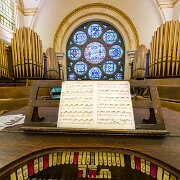
6 St. Charles Borromeo Roman Catholic Church is a church located at the corner of Baldwin Avenue and St. Paul Avenue in Detroit, Michigan
In the late 1850s, Belgian Catholics immigrated to Detroit and settled in the eastside neighborhoods near Gratiot and Baldwin. In 1886, a parish dedicated to St. Charles Borromeo was established to minister to this congregation. A wood-frame church was constructed for the parish, and quickly expanded. As Detroit grew, the parish grew along with it, with French, German, Irish, Scotch, and English immigrant congregants in addition to the original Belgians. By 1920, the congregation numbered over 3000. By the 1930s, the school's population also included many Catholic children of Syrian and Italian immigrants.
In 1912, the two-story rectory and school was designed and built by Van Leyen & Schilling. In 1918, Peter Dederichs was awarded a contract to build an "edifice of Romanesque style for religious use". Just four years after the church was completed, it was expanded to meet the needs of the growing congregation.
In the late 1850s, Belgian Catholics immigrated to Detroit and settled in the eastside neighborhoods near Gratiot and Baldwin. In 1886, a parish dedicated to St. Charles Borromeo was established to minister to this congregation. A wood-frame church was constructed for the parish, and quickly expanded. As Detroit grew, the parish grew along with it, with French, German, Irish, Scotch, and English immigrant congregants in addition to the original Belgians. By 1920, the congregation numbered over 3000. By the 1930s, the school's population also included many Catholic children of Syrian and Italian immigrants.
In 1912, the two-story rectory and school was designed and built by Van Leyen & Schilling. In 1918, Peter Dederichs was awarded a contract to build an "edifice of Romanesque style for religious use". Just four years after the church was completed, it was expanded to meet the needs of the growing congregation.
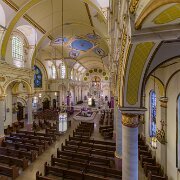
7 St. Charles Borromeo Roman Catholic Church is a church located at the corner of Baldwin Avenue and St. Paul Avenue in Detroit, Michigan
In the late 1850s, Belgian Catholics immigrated to Detroit and settled in the eastside neighborhoods near Gratiot and Baldwin. In 1886, a parish dedicated to St. Charles Borromeo was established to minister to this congregation. A wood-frame church was constructed for the parish, and quickly expanded. As Detroit grew, the parish grew along with it, with French, German, Irish, Scotch, and English immigrant congregants in addition to the original Belgians. By 1920, the congregation numbered over 3000. By the 1930s, the school's population also included many Catholic children of Syrian and Italian immigrants.
In 1912, the two-story rectory and school was designed and built by Van Leyen & Schilling. In 1918, Peter Dederichs was awarded a contract to build an "edifice of Romanesque style for religious use". Just four years after the church was completed, it was expanded to meet the needs of the growing congregation.
In the late 1850s, Belgian Catholics immigrated to Detroit and settled in the eastside neighborhoods near Gratiot and Baldwin. In 1886, a parish dedicated to St. Charles Borromeo was established to minister to this congregation. A wood-frame church was constructed for the parish, and quickly expanded. As Detroit grew, the parish grew along with it, with French, German, Irish, Scotch, and English immigrant congregants in addition to the original Belgians. By 1920, the congregation numbered over 3000. By the 1930s, the school's population also included many Catholic children of Syrian and Italian immigrants.
In 1912, the two-story rectory and school was designed and built by Van Leyen & Schilling. In 1918, Peter Dederichs was awarded a contract to build an "edifice of Romanesque style for religious use". Just four years after the church was completed, it was expanded to meet the needs of the growing congregation.
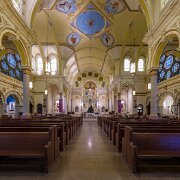
8 St. Charles Borromeo Roman Catholic Church is a church located at the corner of Baldwin Avenue and St. Paul Avenue in Detroit, Michigan
In the late 1850s, Belgian Catholics immigrated to Detroit and settled in the eastside neighborhoods near Gratiot and Baldwin. In 1886, a parish dedicated to St. Charles Borromeo was established to minister to this congregation. A wood-frame church was constructed for the parish, and quickly expanded. As Detroit grew, the parish grew along with it, with French, German, Irish, Scotch, and English immigrant congregants in addition to the original Belgians. By 1920, the congregation numbered over 3000. By the 1930s, the school's population also included many Catholic children of Syrian and Italian immigrants.
In 1912, the two-story rectory and school was designed and built by Van Leyen & Schilling. In 1918, Peter Dederichs was awarded a contract to build an "edifice of Romanesque style for religious use". Just four years after the church was completed, it was expanded to meet the needs of the growing congregation.
In the late 1850s, Belgian Catholics immigrated to Detroit and settled in the eastside neighborhoods near Gratiot and Baldwin. In 1886, a parish dedicated to St. Charles Borromeo was established to minister to this congregation. A wood-frame church was constructed for the parish, and quickly expanded. As Detroit grew, the parish grew along with it, with French, German, Irish, Scotch, and English immigrant congregants in addition to the original Belgians. By 1920, the congregation numbered over 3000. By the 1930s, the school's population also included many Catholic children of Syrian and Italian immigrants.
In 1912, the two-story rectory and school was designed and built by Van Leyen & Schilling. In 1918, Peter Dederichs was awarded a contract to build an "edifice of Romanesque style for religious use". Just four years after the church was completed, it was expanded to meet the needs of the growing congregation.
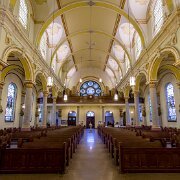
9 St. Charles Borromeo Roman Catholic Church is a church located at the corner of Baldwin Avenue and St. Paul Avenue in Detroit, Michigan
In the late 1850s, Belgian Catholics immigrated to Detroit and settled in the eastside neighborhoods near Gratiot and Baldwin. In 1886, a parish dedicated to St. Charles Borromeo was established to minister to this congregation. A wood-frame church was constructed for the parish, and quickly expanded. As Detroit grew, the parish grew along with it, with French, German, Irish, Scotch, and English immigrant congregants in addition to the original Belgians. By 1920, the congregation numbered over 3000. By the 1930s, the school's population also included many Catholic children of Syrian and Italian immigrants.
In 1912, the two-story rectory and school was designed and built by Van Leyen & Schilling. In 1918, Peter Dederichs was awarded a contract to build an "edifice of Romanesque style for religious use". Just four years after the church was completed, it was expanded to meet the needs of the growing congregation.
In the late 1850s, Belgian Catholics immigrated to Detroit and settled in the eastside neighborhoods near Gratiot and Baldwin. In 1886, a parish dedicated to St. Charles Borromeo was established to minister to this congregation. A wood-frame church was constructed for the parish, and quickly expanded. As Detroit grew, the parish grew along with it, with French, German, Irish, Scotch, and English immigrant congregants in addition to the original Belgians. By 1920, the congregation numbered over 3000. By the 1930s, the school's population also included many Catholic children of Syrian and Italian immigrants.
In 1912, the two-story rectory and school was designed and built by Van Leyen & Schilling. In 1918, Peter Dederichs was awarded a contract to build an "edifice of Romanesque style for religious use". Just four years after the church was completed, it was expanded to meet the needs of the growing congregation.
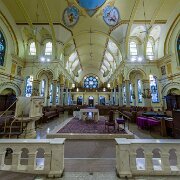
10 St. Charles Borromeo Roman Catholic Church is a church located at the corner of Baldwin Avenue and St. Paul Avenue in Detroit, Michigan
In the late 1850s, Belgian Catholics immigrated to Detroit and settled in the eastside neighborhoods near Gratiot and Baldwin. In 1886, a parish dedicated to St. Charles Borromeo was established to minister to this congregation. A wood-frame church was constructed for the parish, and quickly expanded. As Detroit grew, the parish grew along with it, with French, German, Irish, Scotch, and English immigrant congregants in addition to the original Belgians. By 1920, the congregation numbered over 3000. By the 1930s, the school's population also included many Catholic children of Syrian and Italian immigrants.
In 1912, the two-story rectory and school was designed and built by Van Leyen & Schilling. In 1918, Peter Dederichs was awarded a contract to build an "edifice of Romanesque style for religious use". Just four years after the church was completed, it was expanded to meet the needs of the growing congregation.
In the late 1850s, Belgian Catholics immigrated to Detroit and settled in the eastside neighborhoods near Gratiot and Baldwin. In 1886, a parish dedicated to St. Charles Borromeo was established to minister to this congregation. A wood-frame church was constructed for the parish, and quickly expanded. As Detroit grew, the parish grew along with it, with French, German, Irish, Scotch, and English immigrant congregants in addition to the original Belgians. By 1920, the congregation numbered over 3000. By the 1930s, the school's population also included many Catholic children of Syrian and Italian immigrants.
In 1912, the two-story rectory and school was designed and built by Van Leyen & Schilling. In 1918, Peter Dederichs was awarded a contract to build an "edifice of Romanesque style for religious use". Just four years after the church was completed, it was expanded to meet the needs of the growing congregation.
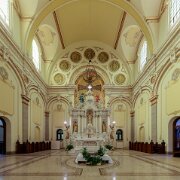
11 St. Charles Borromeo Catholic Church, Detroit, Michigan.
St. Charles was established in 1886 in a largely Belgian area. The first church was a small frame building on Field Avenue, between Agnes and St. Paul and was built mostly by parishioners. The parish school held classes in the church building. By 1897 the parish included members of French, Belgian, German, Scotch, and Irish ancestry. By 1920, most of the 3,000 members of the parish were American born. Even enlarged, the old frame church could not accommodate the congregation and construction of a new building was begun in 1918. The Detroit architect and parishioner Peter Dedericks designed the new church in early Renaissance-Romanesque style. The basement of the new church building housed the elementary school. The school building next to the church housed the high school. Both the school building and the rectory were built in 1912 and still stand.
In the 1960's and 70's St. Charles, like many city parishes faced dwindling membership and struggled to survive. The school was closed and the building was eventually sold. In the 1980's St. Charles faced closure. This sad end was averted under the leadership of Father David Preuss, OFM, Capuchin. The small core of remaining parishioners banded together to implement roof repairs, boiler replacement, and began to rebuild their community. An ambitious project was undertaken to involve the parish in both neighborhood and church restoration. The church renovations included a total repainting of the interior in a style complimenting its design and adding several ceiling murals to represent the multi-ethnic community of the parish. Additional work in the church included lighting and electrical upgrades and maintaining the Wurlitzer pipe organ (one of only two of its type remaining in service). The parish was designated a Historic District on June 20, 1986 and was re-dedicated in November of 1995.
Today, the St. Charles parish is a true representation of the diversity of the metropolitan Detroit area. Under the current leadership of Monsignor Daniel J. Trapp. St. Charles has grown not only in membership, but in dedication to being a very strong anchor in the neighborhood and the parish continues to serve the spiritual and human needs of the near east side neighborhood it has served for more than 125 years.
St. Charles was established in 1886 in a largely Belgian area. The first church was a small frame building on Field Avenue, between Agnes and St. Paul and was built mostly by parishioners. The parish school held classes in the church building. By 1897 the parish included members of French, Belgian, German, Scotch, and Irish ancestry. By 1920, most of the 3,000 members of the parish were American born. Even enlarged, the old frame church could not accommodate the congregation and construction of a new building was begun in 1918. The Detroit architect and parishioner Peter Dedericks designed the new church in early Renaissance-Romanesque style. The basement of the new church building housed the elementary school. The school building next to the church housed the high school. Both the school building and the rectory were built in 1912 and still stand.
In the 1960's and 70's St. Charles, like many city parishes faced dwindling membership and struggled to survive. The school was closed and the building was eventually sold. In the 1980's St. Charles faced closure. This sad end was averted under the leadership of Father David Preuss, OFM, Capuchin. The small core of remaining parishioners banded together to implement roof repairs, boiler replacement, and began to rebuild their community. An ambitious project was undertaken to involve the parish in both neighborhood and church restoration. The church renovations included a total repainting of the interior in a style complimenting its design and adding several ceiling murals to represent the multi-ethnic community of the parish. Additional work in the church included lighting and electrical upgrades and maintaining the Wurlitzer pipe organ (one of only two of its type remaining in service). The parish was designated a Historic District on June 20, 1986 and was re-dedicated in November of 1995.
Today, the St. Charles parish is a true representation of the diversity of the metropolitan Detroit area. Under the current leadership of Monsignor Daniel J. Trapp. St. Charles has grown not only in membership, but in dedication to being a very strong anchor in the neighborhood and the parish continues to serve the spiritual and human needs of the near east side neighborhood it has served for more than 125 years.
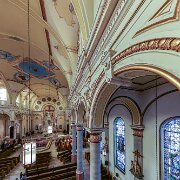
12 St. Charles Borromeo Catholic Church, Detroit, Michigan.
St. Charles was established in 1886 in a largely Belgian area. The first church was a small frame building on Field Avenue, between Agnes and St. Paul and was built mostly by parishioners. The parish school held classes in the church building. By 1897 the parish included members of French, Belgian, German, Scotch, and Irish ancestry. By 1920, most of the 3,000 members of the parish were American born. Even enlarged, the old frame church could not accommodate the congregation and construction of a new building was begun in 1918. The Detroit architect and parishioner Peter Dedericks designed the new church in early Renaissance-Romanesque style. The basement of the new church building housed the elementary school. The school building next to the church housed the high school. Both the school building and the rectory were built in 1912 and still stand.
In the 1960's and 70's St. Charles, like many city parishes faced dwindling membership and struggled to survive. The school was closed and the building was eventually sold. In the 1980's St. Charles faced closure. This sad end was averted under the leadership of Father David Preuss, OFM, Capuchin. The small core of remaining parishioners banded together to implement roof repairs, boiler replacement, and began to rebuild their community. An ambitious project was undertaken to involve the parish in both neighborhood and church restoration. The church renovations included a total repainting of the interior in a style complimenting its design and adding several ceiling murals to represent the multi-ethnic community of the parish. Additional work in the church included lighting and electrical upgrades and maintaining the Wurlitzer pipe organ (one of only two of its type remaining in service). The parish was designated a Historic District on June 20, 1986 and was re-dedicated in November of 1995.
Today, the St. Charles parish is a true representation of the diversity of the metropolitan Detroit area. Under the current leadership of Monsignor Daniel J. Trapp. St. Charles has grown not only in membership, but in dedication to being a very strong anchor in the neighborhood and the parish continues to serve the spiritual and human needs of the near east side neighborhood it has served for more than 125 years.
St. Charles was established in 1886 in a largely Belgian area. The first church was a small frame building on Field Avenue, between Agnes and St. Paul and was built mostly by parishioners. The parish school held classes in the church building. By 1897 the parish included members of French, Belgian, German, Scotch, and Irish ancestry. By 1920, most of the 3,000 members of the parish were American born. Even enlarged, the old frame church could not accommodate the congregation and construction of a new building was begun in 1918. The Detroit architect and parishioner Peter Dedericks designed the new church in early Renaissance-Romanesque style. The basement of the new church building housed the elementary school. The school building next to the church housed the high school. Both the school building and the rectory were built in 1912 and still stand.
In the 1960's and 70's St. Charles, like many city parishes faced dwindling membership and struggled to survive. The school was closed and the building was eventually sold. In the 1980's St. Charles faced closure. This sad end was averted under the leadership of Father David Preuss, OFM, Capuchin. The small core of remaining parishioners banded together to implement roof repairs, boiler replacement, and began to rebuild their community. An ambitious project was undertaken to involve the parish in both neighborhood and church restoration. The church renovations included a total repainting of the interior in a style complimenting its design and adding several ceiling murals to represent the multi-ethnic community of the parish. Additional work in the church included lighting and electrical upgrades and maintaining the Wurlitzer pipe organ (one of only two of its type remaining in service). The parish was designated a Historic District on June 20, 1986 and was re-dedicated in November of 1995.
Today, the St. Charles parish is a true representation of the diversity of the metropolitan Detroit area. Under the current leadership of Monsignor Daniel J. Trapp. St. Charles has grown not only in membership, but in dedication to being a very strong anchor in the neighborhood and the parish continues to serve the spiritual and human needs of the near east side neighborhood it has served for more than 125 years.
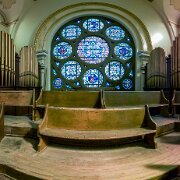
13 St. Charles Borromeo Catholic Church, Detroit, Michigan.
St. Charles was established in 1886 in a largely Belgian area. The first church was a small frame building on Field Avenue, between Agnes and St. Paul and was built mostly by parishioners. The parish school held classes in the church building. By 1897 the parish included members of French, Belgian, German, Scotch, and Irish ancestry. By 1920, most of the 3,000 members of the parish were American born. Even enlarged, the old frame church could not accommodate the congregation and construction of a new building was begun in 1918. The Detroit architect and parishioner Peter Dedericks designed the new church in early Renaissance-Romanesque style. The basement of the new church building housed the elementary school. The school building next to the church housed the high school. Both the school building and the rectory were built in 1912 and still stand.
In the 1960's and 70's St. Charles, like many city parishes faced dwindling membership and struggled to survive. The school was closed and the building was eventually sold. In the 1980's St. Charles faced closure. This sad end was averted under the leadership of Father David Preuss, OFM, Capuchin. The small core of remaining parishioners banded together to implement roof repairs, boiler replacement, and began to rebuild their community. An ambitious project was undertaken to involve the parish in both neighborhood and church restoration. The church renovations included a total repainting of the interior in a style complimenting its design and adding several ceiling murals to represent the multi-ethnic community of the parish. Additional work in the church included lighting and electrical upgrades and maintaining the Wurlitzer pipe organ (one of only two of its type remaining in service). The parish was designated a Historic District on June 20, 1986 and was re-dedicated in November of 1995.
Today, the St. Charles parish is a true representation of the diversity of the metropolitan Detroit area. Under the current leadership of Monsignor Daniel J. Trapp. St. Charles has grown not only in membership, but in dedication to being a very strong anchor in the neighborhood and the parish continues to serve the spiritual and human needs of the near east side neighborhood it has served for more than 125 years.
St. Charles was established in 1886 in a largely Belgian area. The first church was a small frame building on Field Avenue, between Agnes and St. Paul and was built mostly by parishioners. The parish school held classes in the church building. By 1897 the parish included members of French, Belgian, German, Scotch, and Irish ancestry. By 1920, most of the 3,000 members of the parish were American born. Even enlarged, the old frame church could not accommodate the congregation and construction of a new building was begun in 1918. The Detroit architect and parishioner Peter Dedericks designed the new church in early Renaissance-Romanesque style. The basement of the new church building housed the elementary school. The school building next to the church housed the high school. Both the school building and the rectory were built in 1912 and still stand.
In the 1960's and 70's St. Charles, like many city parishes faced dwindling membership and struggled to survive. The school was closed and the building was eventually sold. In the 1980's St. Charles faced closure. This sad end was averted under the leadership of Father David Preuss, OFM, Capuchin. The small core of remaining parishioners banded together to implement roof repairs, boiler replacement, and began to rebuild their community. An ambitious project was undertaken to involve the parish in both neighborhood and church restoration. The church renovations included a total repainting of the interior in a style complimenting its design and adding several ceiling murals to represent the multi-ethnic community of the parish. Additional work in the church included lighting and electrical upgrades and maintaining the Wurlitzer pipe organ (one of only two of its type remaining in service). The parish was designated a Historic District on June 20, 1986 and was re-dedicated in November of 1995.
Today, the St. Charles parish is a true representation of the diversity of the metropolitan Detroit area. Under the current leadership of Monsignor Daniel J. Trapp. St. Charles has grown not only in membership, but in dedication to being a very strong anchor in the neighborhood and the parish continues to serve the spiritual and human needs of the near east side neighborhood it has served for more than 125 years.
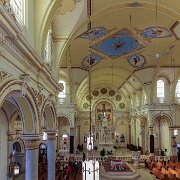
14 St. Charles Borromeo Catholic Church, Detroit, Michigan.
St. Charles was established in 1886 in a largely Belgian area. The first church was a small frame building on Field Avenue, between Agnes and St. Paul and was built mostly by parishioners. The parish school held classes in the church building. By 1897 the parish included members of French, Belgian, German, Scotch, and Irish ancestry. By 1920, most of the 3,000 members of the parish were American born. Even enlarged, the old frame church could not accommodate the congregation and construction of a new building was begun in 1918. The Detroit architect and parishioner Peter Dedericks designed the new church in early Renaissance-Romanesque style. The basement of the new church building housed the elementary school. The school building next to the church housed the high school. Both the school building and the rectory were built in 1912 and still stand.
In the 1960's and 70's St. Charles, like many city parishes faced dwindling membership and struggled to survive. The school was closed and the building was eventually sold. In the 1980's St. Charles faced closure. This sad end was averted under the leadership of Father David Preuss, OFM, Capuchin. The small core of remaining parishioners banded together to implement roof repairs, boiler replacement, and began to rebuild their community. An ambitious project was undertaken to involve the parish in both neighborhood and church restoration. The church renovations included a total repainting of the interior in a style complimenting its design and adding several ceiling murals to represent the multi-ethnic community of the parish. Additional work in the church included lighting and electrical upgrades and maintaining the Wurlitzer pipe organ (one of only two of its type remaining in service). The parish was designated a Historic District on June 20, 1986 and was re-dedicated in November of 1995.
Today, the St. Charles parish is a true representation of the diversity of the metropolitan Detroit area. Under the current leadership of Monsignor Daniel J. Trapp. St. Charles has grown not only in membership, but in dedication to being a very strong anchor in the neighborhood and the parish continues to serve the spiritual and human needs of the near east side neighborhood it has served for more than 125 years.
St. Charles was established in 1886 in a largely Belgian area. The first church was a small frame building on Field Avenue, between Agnes and St. Paul and was built mostly by parishioners. The parish school held classes in the church building. By 1897 the parish included members of French, Belgian, German, Scotch, and Irish ancestry. By 1920, most of the 3,000 members of the parish were American born. Even enlarged, the old frame church could not accommodate the congregation and construction of a new building was begun in 1918. The Detroit architect and parishioner Peter Dedericks designed the new church in early Renaissance-Romanesque style. The basement of the new church building housed the elementary school. The school building next to the church housed the high school. Both the school building and the rectory were built in 1912 and still stand.
In the 1960's and 70's St. Charles, like many city parishes faced dwindling membership and struggled to survive. The school was closed and the building was eventually sold. In the 1980's St. Charles faced closure. This sad end was averted under the leadership of Father David Preuss, OFM, Capuchin. The small core of remaining parishioners banded together to implement roof repairs, boiler replacement, and began to rebuild their community. An ambitious project was undertaken to involve the parish in both neighborhood and church restoration. The church renovations included a total repainting of the interior in a style complimenting its design and adding several ceiling murals to represent the multi-ethnic community of the parish. Additional work in the church included lighting and electrical upgrades and maintaining the Wurlitzer pipe organ (one of only two of its type remaining in service). The parish was designated a Historic District on June 20, 1986 and was re-dedicated in November of 1995.
Today, the St. Charles parish is a true representation of the diversity of the metropolitan Detroit area. Under the current leadership of Monsignor Daniel J. Trapp. St. Charles has grown not only in membership, but in dedication to being a very strong anchor in the neighborhood and the parish continues to serve the spiritual and human needs of the near east side neighborhood it has served for more than 125 years.
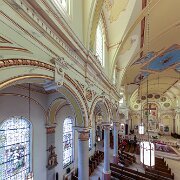
15 St. Charles Borromeo Catholic Church, Detroit, Michigan.
St. Charles was established in 1886 in a largely Belgian area. The first church was a small frame building on Field Avenue, between Agnes and St. Paul and was built mostly by parishioners. The parish school held classes in the church building. By 1897 the parish included members of French, Belgian, German, Scotch, and Irish ancestry. By 1920, most of the 3,000 members of the parish were American born. Even enlarged, the old frame church could not accommodate the congregation and construction of a new building was begun in 1918. The Detroit architect and parishioner Peter Dedericks designed the new church in early Renaissance-Romanesque style. The basement of the new church building housed the elementary school. The school building next to the church housed the high school. Both the school building and the rectory were built in 1912 and still stand.
In the 1960's and 70's St. Charles, like many city parishes faced dwindling membership and struggled to survive. The school was closed and the building was eventually sold. In the 1980's St. Charles faced closure. This sad end was averted under the leadership of Father David Preuss, OFM, Capuchin. The small core of remaining parishioners banded together to implement roof repairs, boiler replacement, and began to rebuild their community. An ambitious project was undertaken to involve the parish in both neighborhood and church restoration. The church renovations included a total repainting of the interior in a style complimenting its design and adding several ceiling murals to represent the multi-ethnic community of the parish. Additional work in the church included lighting and electrical upgrades and maintaining the Wurlitzer pipe organ (one of only two of its type remaining in service). The parish was designated a Historic District on June 20, 1986 and was re-dedicated in November of 1995.
Today, the St. Charles parish is a true representation of the diversity of the metropolitan Detroit area. Under the current leadership of Monsignor Daniel J. Trapp. St. Charles has grown not only in membership, but in dedication to being a very strong anchor in the neighborhood and the parish continues to serve the spiritual and human needs of the near east side neighborhood it has served for more than 125 years.
St. Charles was established in 1886 in a largely Belgian area. The first church was a small frame building on Field Avenue, between Agnes and St. Paul and was built mostly by parishioners. The parish school held classes in the church building. By 1897 the parish included members of French, Belgian, German, Scotch, and Irish ancestry. By 1920, most of the 3,000 members of the parish were American born. Even enlarged, the old frame church could not accommodate the congregation and construction of a new building was begun in 1918. The Detroit architect and parishioner Peter Dedericks designed the new church in early Renaissance-Romanesque style. The basement of the new church building housed the elementary school. The school building next to the church housed the high school. Both the school building and the rectory were built in 1912 and still stand.
In the 1960's and 70's St. Charles, like many city parishes faced dwindling membership and struggled to survive. The school was closed and the building was eventually sold. In the 1980's St. Charles faced closure. This sad end was averted under the leadership of Father David Preuss, OFM, Capuchin. The small core of remaining parishioners banded together to implement roof repairs, boiler replacement, and began to rebuild their community. An ambitious project was undertaken to involve the parish in both neighborhood and church restoration. The church renovations included a total repainting of the interior in a style complimenting its design and adding several ceiling murals to represent the multi-ethnic community of the parish. Additional work in the church included lighting and electrical upgrades and maintaining the Wurlitzer pipe organ (one of only two of its type remaining in service). The parish was designated a Historic District on June 20, 1986 and was re-dedicated in November of 1995.
Today, the St. Charles parish is a true representation of the diversity of the metropolitan Detroit area. Under the current leadership of Monsignor Daniel J. Trapp. St. Charles has grown not only in membership, but in dedication to being a very strong anchor in the neighborhood and the parish continues to serve the spiritual and human needs of the near east side neighborhood it has served for more than 125 years.
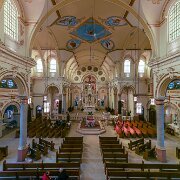
16 St. Charles Borromeo Catholic Church, Detroit, Michigan.
St. Charles was established in 1886 in a largely Belgian area. The first church was a small frame building on Field Avenue, between Agnes and St. Paul and was built mostly by parishioners. The parish school held classes in the church building. By 1897 the parish included members of French, Belgian, German, Scotch, and Irish ancestry. By 1920, most of the 3,000 members of the parish were American born. Even enlarged, the old frame church could not accommodate the congregation and construction of a new building was begun in 1918. The Detroit architect and parishioner Peter Dedericks designed the new church in early Renaissance-Romanesque style. The basement of the new church building housed the elementary school. The school building next to the church housed the high school. Both the school building and the rectory were built in 1912 and still stand.
In the 1960's and 70's St. Charles, like many city parishes faced dwindling membership and struggled to survive. The school was closed and the building was eventually sold. In the 1980's St. Charles faced closure. This sad end was averted under the leadership of Father David Preuss, OFM, Capuchin. The small core of remaining parishioners banded together to implement roof repairs, boiler replacement, and began to rebuild their community. An ambitious project was undertaken to involve the parish in both neighborhood and church restoration. The church renovations included a total repainting of the interior in a style complimenting its design and adding several ceiling murals to represent the multi-ethnic community of the parish. Additional work in the church included lighting and electrical upgrades and maintaining the Wurlitzer pipe organ (one of only two of its type remaining in service). The parish was designated a Historic District on June 20, 1986 and was re-dedicated in November of 1995.
Today, the St. Charles parish is a true representation of the diversity of the metropolitan Detroit area. Under the current leadership of Monsignor Daniel J. Trapp. St. Charles has grown not only in membership, but in dedication to being a very strong anchor in the neighborhood and the parish continues to serve the spiritual and human needs of the near east side neighborhood it has served for more than 125 years.
St. Charles was established in 1886 in a largely Belgian area. The first church was a small frame building on Field Avenue, between Agnes and St. Paul and was built mostly by parishioners. The parish school held classes in the church building. By 1897 the parish included members of French, Belgian, German, Scotch, and Irish ancestry. By 1920, most of the 3,000 members of the parish were American born. Even enlarged, the old frame church could not accommodate the congregation and construction of a new building was begun in 1918. The Detroit architect and parishioner Peter Dedericks designed the new church in early Renaissance-Romanesque style. The basement of the new church building housed the elementary school. The school building next to the church housed the high school. Both the school building and the rectory were built in 1912 and still stand.
In the 1960's and 70's St. Charles, like many city parishes faced dwindling membership and struggled to survive. The school was closed and the building was eventually sold. In the 1980's St. Charles faced closure. This sad end was averted under the leadership of Father David Preuss, OFM, Capuchin. The small core of remaining parishioners banded together to implement roof repairs, boiler replacement, and began to rebuild their community. An ambitious project was undertaken to involve the parish in both neighborhood and church restoration. The church renovations included a total repainting of the interior in a style complimenting its design and adding several ceiling murals to represent the multi-ethnic community of the parish. Additional work in the church included lighting and electrical upgrades and maintaining the Wurlitzer pipe organ (one of only two of its type remaining in service). The parish was designated a Historic District on June 20, 1986 and was re-dedicated in November of 1995.
Today, the St. Charles parish is a true representation of the diversity of the metropolitan Detroit area. Under the current leadership of Monsignor Daniel J. Trapp. St. Charles has grown not only in membership, but in dedication to being a very strong anchor in the neighborhood and the parish continues to serve the spiritual and human needs of the near east side neighborhood it has served for more than 125 years.
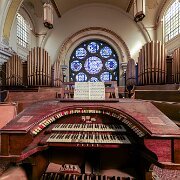
17 St. Charles Borromeo Catholic Church, Detroit, Michigan.
St. Charles was established in 1886 in a largely Belgian area. The first church was a small frame building on Field Avenue, between Agnes and St. Paul and was built mostly by parishioners. The parish school held classes in the church building. By 1897 the parish included members of French, Belgian, German, Scotch, and Irish ancestry. By 1920, most of the 3,000 members of the parish were American born. Even enlarged, the old frame church could not accommodate the congregation and construction of a new building was begun in 1918. The Detroit architect and parishioner Peter Dedericks designed the new church in early Renaissance-Romanesque style. The basement of the new church building housed the elementary school. The school building next to the church housed the high school. Both the school building and the rectory were built in 1912 and still stand.
In the 1960's and 70's St. Charles, like many city parishes faced dwindling membership and struggled to survive. The school was closed and the building was eventually sold. In the 1980's St. Charles faced closure. This sad end was averted under the leadership of Father David Preuss, OFM, Capuchin. The small core of remaining parishioners banded together to implement roof repairs, boiler replacement, and began to rebuild their community. An ambitious project was undertaken to involve the parish in both neighborhood and church restoration. The church renovations included a total repainting of the interior in a style complimenting its design and adding several ceiling murals to represent the multi-ethnic community of the parish. Additional work in the church included lighting and electrical upgrades and maintaining the Wurlitzer pipe organ (one of only two of its type remaining in service). The parish was designated a Historic District on June 20, 1986 and was re-dedicated in November of 1995.
Today, the St. Charles parish is a true representation of the diversity of the metropolitan Detroit area. Under the current leadership of Monsignor Daniel J. Trapp. St. Charles has grown not only in membership, but in dedication to being a very strong anchor in the neighborhood and the parish continues to serve the spiritual and human needs of the near east side neighborhood it has served for more than 125 years.
St. Charles was established in 1886 in a largely Belgian area. The first church was a small frame building on Field Avenue, between Agnes and St. Paul and was built mostly by parishioners. The parish school held classes in the church building. By 1897 the parish included members of French, Belgian, German, Scotch, and Irish ancestry. By 1920, most of the 3,000 members of the parish were American born. Even enlarged, the old frame church could not accommodate the congregation and construction of a new building was begun in 1918. The Detroit architect and parishioner Peter Dedericks designed the new church in early Renaissance-Romanesque style. The basement of the new church building housed the elementary school. The school building next to the church housed the high school. Both the school building and the rectory were built in 1912 and still stand.
In the 1960's and 70's St. Charles, like many city parishes faced dwindling membership and struggled to survive. The school was closed and the building was eventually sold. In the 1980's St. Charles faced closure. This sad end was averted under the leadership of Father David Preuss, OFM, Capuchin. The small core of remaining parishioners banded together to implement roof repairs, boiler replacement, and began to rebuild their community. An ambitious project was undertaken to involve the parish in both neighborhood and church restoration. The church renovations included a total repainting of the interior in a style complimenting its design and adding several ceiling murals to represent the multi-ethnic community of the parish. Additional work in the church included lighting and electrical upgrades and maintaining the Wurlitzer pipe organ (one of only two of its type remaining in service). The parish was designated a Historic District on June 20, 1986 and was re-dedicated in November of 1995.
Today, the St. Charles parish is a true representation of the diversity of the metropolitan Detroit area. Under the current leadership of Monsignor Daniel J. Trapp. St. Charles has grown not only in membership, but in dedication to being a very strong anchor in the neighborhood and the parish continues to serve the spiritual and human needs of the near east side neighborhood it has served for more than 125 years.
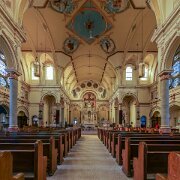
18 St. Charles Borromeo Catholic Church, Detroit, Michigan.
St. Charles was established in 1886 in a largely Belgian area. The first church was a small frame building on Field Avenue, between Agnes and St. Paul and was built mostly by parishioners. The parish school held classes in the church building. By 1897 the parish included members of French, Belgian, German, Scotch, and Irish ancestry. By 1920, most of the 3,000 members of the parish were American born. Even enlarged, the old frame church could not accommodate the congregation and construction of a new building was begun in 1918. The Detroit architect and parishioner Peter Dedericks designed the new church in early Renaissance-Romanesque style. The basement of the new church building housed the elementary school. The school building next to the church housed the high school. Both the school building and the rectory were built in 1912 and still stand.
In the 1960's and 70's St. Charles, like many city parishes faced dwindling membership and struggled to survive. The school was closed and the building was eventually sold. In the 1980's St. Charles faced closure. This sad end was averted under the leadership of Father David Preuss, OFM, Capuchin. The small core of remaining parishioners banded together to implement roof repairs, boiler replacement, and began to rebuild their community. An ambitious project was undertaken to involve the parish in both neighborhood and church restoration. The church renovations included a total repainting of the interior in a style complimenting its design and adding several ceiling murals to represent the multi-ethnic community of the parish. Additional work in the church included lighting and electrical upgrades and maintaining the Wurlitzer pipe organ (one of only two of its type remaining in service). The parish was designated a Historic District on June 20, 1986 and was re-dedicated in November of 1995.
Today, the St. Charles parish is a true representation of the diversity of the metropolitan Detroit area. Under the current leadership of Monsignor Daniel J. Trapp. St. Charles has grown not only in membership, but in dedication to being a very strong anchor in the neighborhood and the parish continues to serve the spiritual and human needs of the near east side neighborhood it has served for more than 125 years.
St. Charles was established in 1886 in a largely Belgian area. The first church was a small frame building on Field Avenue, between Agnes and St. Paul and was built mostly by parishioners. The parish school held classes in the church building. By 1897 the parish included members of French, Belgian, German, Scotch, and Irish ancestry. By 1920, most of the 3,000 members of the parish were American born. Even enlarged, the old frame church could not accommodate the congregation and construction of a new building was begun in 1918. The Detroit architect and parishioner Peter Dedericks designed the new church in early Renaissance-Romanesque style. The basement of the new church building housed the elementary school. The school building next to the church housed the high school. Both the school building and the rectory were built in 1912 and still stand.
In the 1960's and 70's St. Charles, like many city parishes faced dwindling membership and struggled to survive. The school was closed and the building was eventually sold. In the 1980's St. Charles faced closure. This sad end was averted under the leadership of Father David Preuss, OFM, Capuchin. The small core of remaining parishioners banded together to implement roof repairs, boiler replacement, and began to rebuild their community. An ambitious project was undertaken to involve the parish in both neighborhood and church restoration. The church renovations included a total repainting of the interior in a style complimenting its design and adding several ceiling murals to represent the multi-ethnic community of the parish. Additional work in the church included lighting and electrical upgrades and maintaining the Wurlitzer pipe organ (one of only two of its type remaining in service). The parish was designated a Historic District on June 20, 1986 and was re-dedicated in November of 1995.
Today, the St. Charles parish is a true representation of the diversity of the metropolitan Detroit area. Under the current leadership of Monsignor Daniel J. Trapp. St. Charles has grown not only in membership, but in dedication to being a very strong anchor in the neighborhood and the parish continues to serve the spiritual and human needs of the near east side neighborhood it has served for more than 125 years.
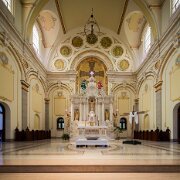
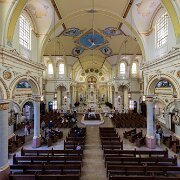
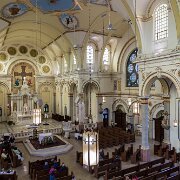
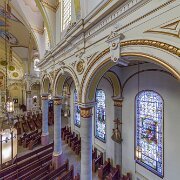
St. Charles Borromeo Church